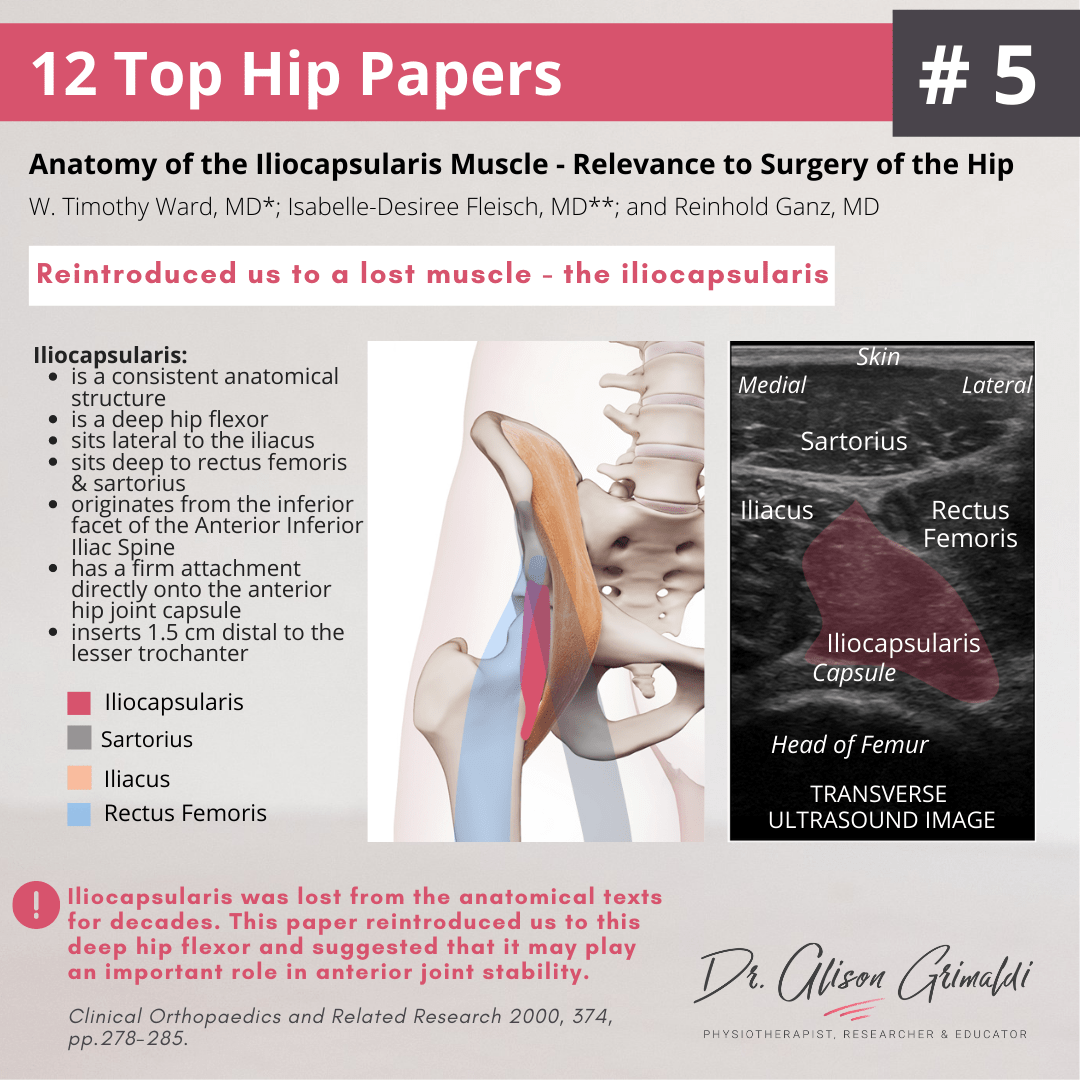5 of 12 Top Hip Papers – Anatomy of the Iliocapsularis muscle

It's Day 5 of my 12 Top Hip Papers series of miniblogs. In the first 4 days, the focus has been on joint-related papers. You can return to the main blog page to find these. We are moving on now to look at a couple of great papers on hip muscle anatomy and function - papers that really advanced our understanding of deep hip musculature. Today our topic is anatomy of the iliocapsularis muscle. Some of you may be frowning a little, searching your memories for this muscle - you may never have even been taught of its existence at Uni! Read on below about the rediscovery of this deep hip flexor.

For your convenience, we have also developed this content into a FREE 26-page full colour ebook!
Packed full of 12 Top Hip Papers - peer reviewed scientific papers that have contributed to our understanding of hip conditions and/or the assessment or management of hip pain or injury.
PAPER 5: Anatomy of the Iliocapsularis muscle
This muscle was effectively lost from anatomical texts and scientific literature for decades prior to this paper. The authors rediscovered it during careful dissection of the anterolateral hip musculature while performing periacetabular osteotomy for acetabular dysplasia. They noted a muscle attached to the anterior hip capsule that was distinct to the iliacus. Searching of the recent literature and anatomical texts returned no information on this muscle but going further back to earlier last century and to German texts they finally found similar accounts of a separate muscle that sits lateral to the iliacus. Subsequently they performed cadaveric dissections of 20 cadavers and found that the iliocapsularis was a consistent and distinct anatomical structure, with strong attachment to the anterior capsule. They described the anatomy of this deep hip flexor and reintroduced it to the modern world.

Key learnings about anatomy of the iliocapsularis:
Iliocapsularis:
- is a consistent anatomical structure,
- is a deep hip flexor,
- sits lateral to the iliacus,
- sits deep to rectus femoris and sartorius muscles,
- originates from the inferior facet of the Anterior Inferior Iliac Spine,
- has a firm attachment directly onto the anterior hip joint capsule, and
- inserts 1.5 cm distal to the lesser trochanter.
These surgeons had also noted apparent hypertrophy of this muscle in those with acetabular dysplasia when visualising the muscle during surgery. With its strong attachment to the capsule, they proposed that this muscle would play an important role in tensioning the capsule and thereby contributing to stability of the hip joint. In those with acetabular dysplasia and early symptoms, hypertrophy of this muscle was interpreted as a positive adaptation in those with deficiency of their bony stability mechanisms.
While this muscle still does not appear in all anatomical texts and many are still unaware of its presence, there is increasing interest in this muscle with electromyographic data now available on its behaviour. We still have much to learn about this long-forgotten muscle, but hopefully it’s presence and importance will not be forgotten again!

Join Hip Academy Today
Join Hip Academy Today
By becoming a member today you can enjoy the benefits of a world class educational Hip Program, specifically designed by Dr Alison Grimaldi to help improve your knowledge surrounding the Hip and Pelvis, and become an expert in your field.
By becoming a member today you can enjoy the benefits of a world class educational Hip Program, specifically designed by Dr Alison Grimaldi to help improve your knowledge surrounding the Hip and Pelvis, and become an expert in your field.
Like to learn more about hip muscle structure and function?
In this course, you can find heaps of information on hip muscle structure, function, dysfunction and implications for exercise prescription. This course is included in Hip Academy, so if you are interested in other courses as well, join me in Hip Academy, and be part of an exclusive global community of physios and health & exercise professionals.



